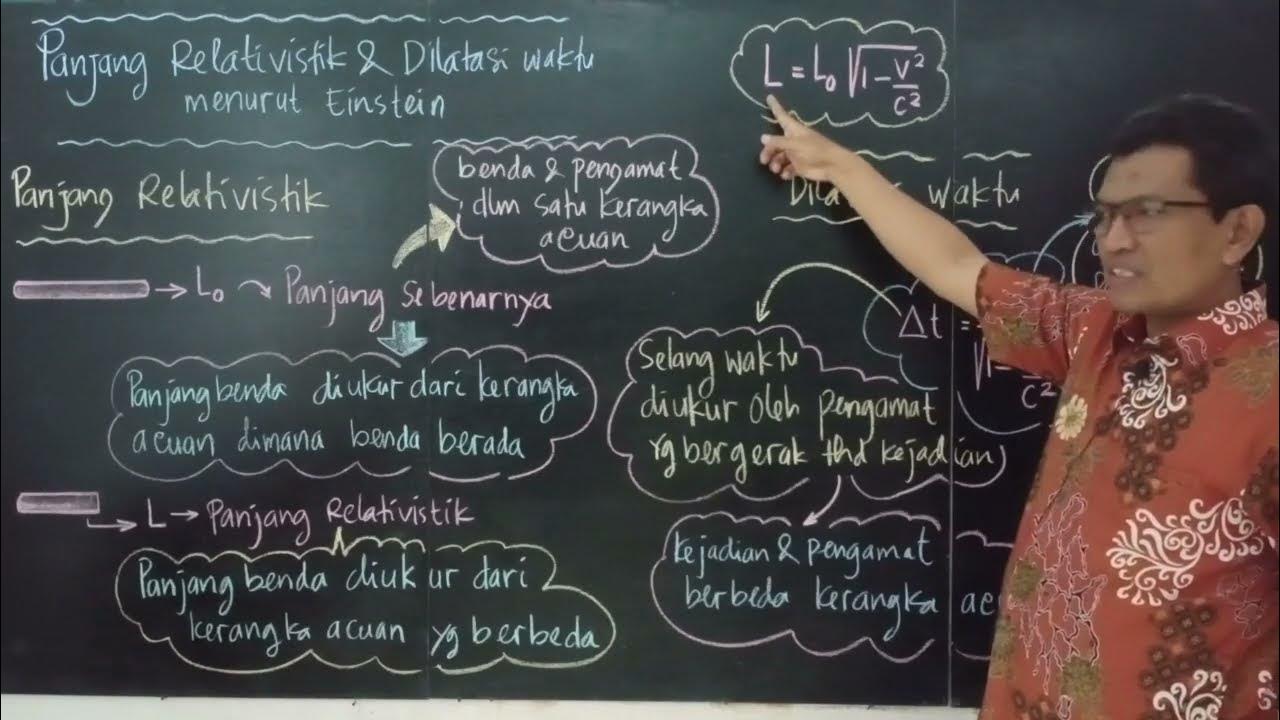Engineering Physics Variation of Mass With Velocity | AKTU Digital Education
Summary
TLDRThe lecture discusses relativistic mechanics, focusing on concepts like velocity addition, length contraction, and the relativity of mass. The instructor uses mathematical equations and examples to explain how objects behave at speeds approaching the speed of light. Key topics include the Lorentz transformation, time dilation, and the increase in mass with velocity, emphasizing the importance of understanding these principles for advanced physics studies.
Takeaways
- 😀 The lecture discusses the concept of relativity, specifically in the context of velocity and its transformations.
- 🌐 The lecturer introduces the idea of reference frames and how the velocity of an object can differ depending on the frame of reference.
- 📚 There's a review of previous lectures where concepts like Lorentz transformation, velocity, and time dilation were covered.
- 🔍 The lecture dives into the specifics of how to calculate the transformations using equations derived from previously discussed theories.
- 📈 Emphasis is placed on understanding the relationship between length contraction, time dilation, and relativistic velocity addition.
- 📝 The lecturer uses examples and formulas to explain how the mass of an object increases with relativistic speeds.
- 🎓 There's a discussion about the implications of these concepts in physics, such as the behavior of particles in an accelerator.
- 🔬 The script mentions the increase in mass with velocity as a verified experimental fact, affecting the perception of mass in different frames.
- 🌌 A practical example is given, involving the behavior of electrons in a cyclotron, to illustrate the principles discussed.
- 📚 The lecture concludes with a recap of the key points and a reminder of the importance of understanding these concepts to progress in the study of relativistic mechanics.
Q & A
What is the main topic discussed in the lecture?
-The main topic discussed in the lecture appears to be related to the concepts of relativity, specifically addressing velocity, mass, and the Lorentz transformation.
What is the significance of the term 'Lorentz transformation' in the context of this lecture?
-The 'Lorentz transformation' is a fundamental concept in the lecture, used to describe the transformation of space and time coordinates between two relatively moving frames of reference, which is crucial for understanding relativistic effects.
What is the concept of 'velocity' discussed in the lecture?
-The concept of 'velocity' in the lecture is discussed in the context of relative motion. It involves how an object's velocity is perceived differently from different frames of reference, a key aspect of the theory of relativity.
How is the term 'mass' used in the lecture?
-In the lecture, 'mass' is used in the context of relativistic mass, which increases with the velocity of the object relative to the observer, as per the theory of special relativity.
What is the role of the Lorentz factor mentioned in the script?
-The Lorentz factor, denoted by the Greek letter 'gamma' (γ), is mentioned as a crucial element in the Lorentz transformation equations. It accounts for time dilation and length contraction effects in special relativity.
What is the relationship between velocity and mass as discussed in the lecture?
-The lecture discusses that as an object's velocity approaches the speed of light, its mass increases. This is in line with the theory of relativity, which states that the mass of an object increases with its velocity.
What is the concept of 'length contraction' referred to in the script?
-Length contraction is a phenomenon in special relativity where the length of an object is measured to be shorter when it is in motion relative to the observer, compared to when it is at rest relative to the observer.
What is the significance of the term 'transformation equations' in the lecture?
-The term 'transformation equations' refers to the mathematical equations used to convert the measurements of space and time from one frame of reference to another in special relativity.
How does the lecture relate the concepts of velocity and time?
-The lecture relates velocity and time through the concept of time dilation, where the time experienced by an observer moving at a high velocity relative to another observer flows slower, as predicted by the theory of relativity.
What is the practical implication of the theory discussed in the lecture?
-The practical implications discussed in the lecture include the effects on objects moving at speeds close to the speed of light, such as those encountered in particle accelerators or theoretical applications in high-energy physics.
What is the role of the speed of light in the theory of relativity as mentioned in the lecture?
-The speed of light is a fundamental constant in the theory of relativity. It is the same in all inertial frames of reference and serves as the ultimate speed limit in the universe, with no material particle able to reach or exceed it.
Outlines

このセクションは有料ユーザー限定です。 アクセスするには、アップグレードをお願いします。
今すぐアップグレードMindmap

このセクションは有料ユーザー限定です。 アクセスするには、アップグレードをお願いします。
今すぐアップグレードKeywords

このセクションは有料ユーザー限定です。 アクセスするには、アップグレードをお願いします。
今すぐアップグレードHighlights

このセクションは有料ユーザー限定です。 アクセスするには、アップグレードをお願いします。
今すぐアップグレードTranscripts

このセクションは有料ユーザー限定です。 アクセスするには、アップグレードをお願いします。
今すぐアップグレード関連動画をさらに表示

Relativitas Einstein (Materi Fisika Kelas XII Semester 2)

MASSA, MOMENTUM DAN ENERGI RELATIVISTIK | Relativitas Einstein - Fisika Kelas 12

Teori Relativitas Khusus Kelas 12 Kurikulum Merdeka | Relativitas; Panjang, Massa, Waktu & Kecepatan

PANJANG RELATIVISTIK & DILATASI WAKTU | Relativitas Einstein - Fisika Kelas 12

Teori Relativitas Khusus: 1. Pendahuluan

Materi Teori Relativitas Khusus - Fisika Kelas 12
5.0 / 5 (0 votes)
